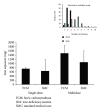Safety and Efficacy of Intravenous Ferric Carboxymaltose (750 mg) in the Treatment of Iron Deficiency Anemia: Two Randomized, Controlled Trials
- PMID: 22997572
- PMCID: PMC3444829
- DOI: 10.1155/2012/172104
Safety and Efficacy of Intravenous Ferric Carboxymaltose (750 mg) in the Treatment of Iron Deficiency Anemia: Two Randomized, Controlled Trials
Abstract
Background. Iron deficiency anemia (IDA) is a common hematological complication with potentially serious clinical consequences that may require intravenous iron therapy. Ferric carboxymaltose (FCM) is a stable, nondextran iron formulation administered intravenously in large single doses to treat IDA. Objective. Two open-label, randomized, placebo-controlled trials evaluated safety of multiple or single 750 mg FCM doses compared to standard medical care (SMC) in IDA patients. Secondary endpoints were improvements in hemoglobin and iron indices. Design and Patients. Adults with hemoglobin ≤12 g/dL, ferritin ≤100 or ≤300 ng/mL with transferrin saturation ≤30% were randomized to receive single (n = 366) or weekly (n = 343) FCM or SMC (n = 360 and n = 366). Results. Significantly greater (P ≤ 0.001) increases in hemoglobin and iron indices occurred in FCM groups versus SMC. In the multidose study, up to two infusions of FCM were needed to reach target iron levels versus 3-5 of intravenous iron comparators. FCM and SMC groups had similar incidences and types of adverse events and serious adverse events. Transient hypophosphatemia not associated with adverse events or clinical sequelae occurred in the FCM groups. Conclusion. Intravenous FCM is safe, well tolerated, and associated with improvements in hemoglobin and iron indices comparable to SMC when administered in single doses of up to 750 mg at a rate of 100 mg/min. Fewer FCM infusions were required to reach target iron levels compared to other intravenous iron preparations.
Figures



References
-
- Killip S, Bennett JM, Chambers MD. Iron deficiency anemia. American Family Physician. 2007;75(5):671–678. - PubMed
-
- Umbreit J. Iron deficiency: a concise review. American Journal of Hematology. 2005;78(3):225–231. - PubMed
-
- Gisbert JP, Gomollón F. Common misconceptions in the diagnosis and management of anemia in inflammatory bowel disease. American Journal of Gastroenterology. 2008;103(5):1299–1307. - PubMed
-
- Haas JD, Brownlie TT. Iron deficiency and reduced work capacity: a critical review of the research to determine a causal relationship. Journal of Nutrition. 2001;131(2):676S–690S. - PubMed
-
- Horton S, Levin C. Commentary on ‘evidence that iron deficiency anemia causes reduced work capacity’. Journal of Nutrition. 2001;131(2):691S–696S. - PubMed
LinkOut - more resources
Full Text Sources
Other Literature Sources

